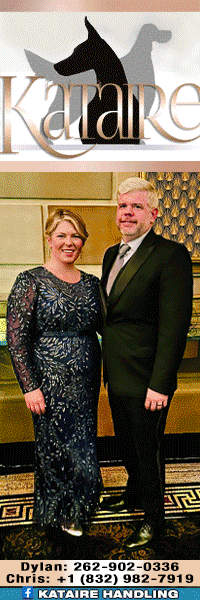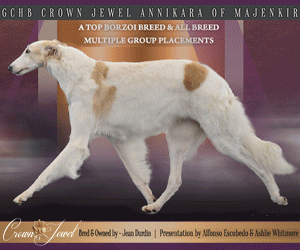Leading Horses to Water…
From Page 88 – November, 2010 Issue
 A year ago my breed standard was changed to include the undocked tail. This action was the eventual result of a judge’s excusal of two European dogs because they had natural tails. The standard at that time simply said, “Tail is docked.” The judge obviously had a very strong aversion to undocked tails. To say that the standard change raised hackles would be a gross understatement. We were accused by many of pandering to the Animal Rights’ groups when in fact it was done to accommodate dogs coming in from FCI countries where docking of tails is no longer legal. We were accused of disavowing our terrier heritage when in fact we viewed it as an opportunity to further clarify tail set-on and carriage. Where the old standard said, “…well set on, carried gaily but never over the back,” it now reads, “Tail is set on high. Docked tail preferred. Whether docked or natural, the tail is carried 90º from the back, either straight or with a slight curve forward. Any deviation from this ideal is to be penalized accordingly.” I would note here the European dogs that were excused would meet the criteria of today’s standard…tails were well set and carried with a slight curve forward.
A year ago my breed standard was changed to include the undocked tail. This action was the eventual result of a judge’s excusal of two European dogs because they had natural tails. The standard at that time simply said, “Tail is docked.” The judge obviously had a very strong aversion to undocked tails. To say that the standard change raised hackles would be a gross understatement. We were accused by many of pandering to the Animal Rights’ groups when in fact it was done to accommodate dogs coming in from FCI countries where docking of tails is no longer legal. We were accused of disavowing our terrier heritage when in fact we viewed it as an opportunity to further clarify tail set-on and carriage. Where the old standard said, “…well set on, carried gaily but never over the back,” it now reads, “Tail is set on high. Docked tail preferred. Whether docked or natural, the tail is carried 90º from the back, either straight or with a slight curve forward. Any deviation from this ideal is to be penalized accordingly.” I would note here the European dogs that were excused would meet the criteria of today’s standard…tails were well set and carried with a slight curve forward.
Never in a million years nor in my wildest dreams did I expect our own breeders in this country to decide not to dock tails. Given that the docked tail is preferred and there is no reason not to dock, I was stunned to find that breeders here are choosing to thumb their noses at this dictate and, further, to ignore the historical significance of the docked tail. It becomes still more heinous since it directly affects the way we are perceived by other terrier people. Montgomery weekend brought out Wheaten Terriers with natural tails in droves! One long-time breeder commented that seeing one or two in the ring was not too hard to take but seeing an entire class of them was more than disturbing. It was a shock to the system. Had these undocked tails been set and carried as the standard states (set on high and straight or slightly curved) they would have been less offensive for sure. But such was not the case. They were curled, arching over the back, either touching it or worse…hanging down to one side, over the loin. One exhibitor, when asked why he was not docking tails, responded, “I’m making a statement.” Unfortunately, the inquirer did not press further. I wondered what that statement might be…perhaps it was, “I don’t like terriers and I wish Wheatens were something else!”
But this tale of tails is just part of the story. There seems to be, across the board, a casual disregard for the standard in general. When a breeder stands ringside and says, “I like a bigger dog,” referencing a dog that would fare well, size-wise anyway, in the Airedale ring, what message is being sent to those neophyte breeders or judges that might overhear the comment? When a breeder of long standing walks into the ring with a dog that looks like a freight train on stumps isn’t the message clear that the breeder feels this dog is true to breed type? Is this sort of thing indicative of a blatant disregard for the standard or is it that the standard is not understood? Either way, the result is disturbing to those with an artist’s eye, those that understand breeding is an art form and requires this artist’s eye. The real problem however is not with the long-time breeders, though many could use what we call “continuing education” to develop a more discerning eye. It is our newer breeders who need educating.
I do not feel the condition is idiosyncratic to my own breed. In discussions with doyennes of other breeds I hear the same story. I recently had a discussion with a prominent breeder of a popular toy breed. She relayed a story about a neophyte whom she was trying to mentor and advise. In the process she suggested that the young woman buy one of the breed’s illustrated standards to study. The response basically was that she did not want to spend $15 and besides she already knew the standard. Another breeder shared her story of a novice breeder/exhibitor who was preparing to advertise a recent win. The photo she planned to use was dreadful and, in her most gentle manner, the breed-elder suggested that she might not want to use it. The novice did not understand and further explained that it was the only one she had. Our breed-elder advised that she hire a photographer and get a photo of her dog that did it justice.
The proof of a breeder’s knowledge, or lack thereof, is not only palpable by what they choose to bring into the ring but also by what they sell as show quality and by the photos they use to advertise their wins. How many times have you looked at a win picture and wondered, “What were they thinking?”
How can we educate breeders when they don’t know that they don’t know? It’s a hard one. The axiom, “You can lead a horse to water but you can’t make him drink” is alive and well here. I honestly feel too many of today’s breeders have no concept of canine anatomy. They can’t tell you the difference between the zygomatic arch and the occipital bone. Further, many fail to recognize the difference between a dog that is crippled and one that isn’t. They have no idea how difficult it is to breed away from long and low…just look around the all-breed rings to see how many breeds are now plagued with long and low. Do breeder/exhibitors ever have someone gait their dog so that they can see for themselves what everyone else including the judge is seeing? An exhibitor speaks of her dog having “four good legs” when in fact he only has three! Some years back I visited a breeder in the midwest to evaluate a litter. I voiced concern over feet… some pup’s feet were splayed. Our standard requires that they be compact with good depth of pad. The breeder looked aghast and said, “Oh no, don’t tell me I have to worry about feet, too?” Yes, all of that, and feet, too!
How many clubs have planned a breeder-education seminar where few-to-none show up? It happens. Our Judge’s Education CD is made available to all judges free of charge and to breeders for a modest sum. Our breeders seldom take advantage of this. One respected breeder posted on our club list, “Do our breeders just not understand, or do they forget to read the Standard occasionally? Or is this an arrogance…”
We expect our judges to understand our respective standards. We are conscientious about offering judges’ seminars and ringside mentoring. Judges also are conscientious in this regard, though often it is simply because AKC requires them to be. Nothing is really required of our neophyte breeders, except perhaps that they sign a code of ethics in which they agree to such banal statements as, “I breed for the characteristics set forth in the Official Standard…” signifying nothing, since often they have no idea what that means. Should this change? Perhaps we need to require our new breeders to buy and study whatever educational tools the parent club has available. We need to plan Breeder Education Seminars and require new breeders to attend prior to becoming full-fledged, voting members. Should we offer a test on canine anatomy? I am just throwing out ideas here. How about ringside mentoring where we watch other breeds noted for correct movement; if yours is a coated breed, watching a non-coated breed such as Dobermans can teach a lot about structure as related to movement. Another valuable learning experience might be attending parent club-endorsed breed seminars on breeds other than ones’ own. Our breeder education programs, in general, need to be more comprehensive than most of them now are.
As judges, we appraise virtues, or at least we should. And we prioritize faults, honoring that “there are no perfect dogs.” As breeders, we must know enough about our breed to effectively do the same, prioritize. Prioritize means, if your standard calls for a square outline, just how much off square is your dog… a lot or just a little? If your standard calls for a rise over the loin, does your dog hold the rise or flatten out on the go-around… if so, to what degree? In both examples, do the virtues atone for the faults?
Finally, a dog can deviate from the standard and still have breed type. It can display the essence of the breed regardless of faults. It is all a matter of degree and this is where the prioritizing comes into play. “I like a bigger dog,” contrasts, perhaps subtly but unmistakably, with “I can forgive a bigger dog if it excels in breed type or has the correct make and shape.” This can, however, prove a difficult concept for the neophyte breeder to wrap his head around. When a dog no longer looks like the breed it is supposed to represent, in the eyes of those who know, it has no business in the ring. It is sad that there are breeders so uneducated as to allow these dogs to be shown. Some are even shown in Bred-By, a class that should be reserved for the very cream of the crop. Bottom line, we, as breed elders, must become more resolute about educating the new people that choose to embrace our respective breeds. We must lead them to the water, wherever it may be, and make them drink!
Short URL: http://caninechronicle.com/?p=1623
Comments are closed












